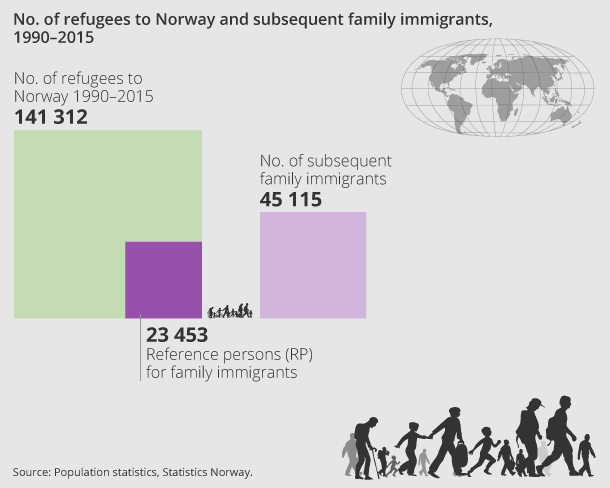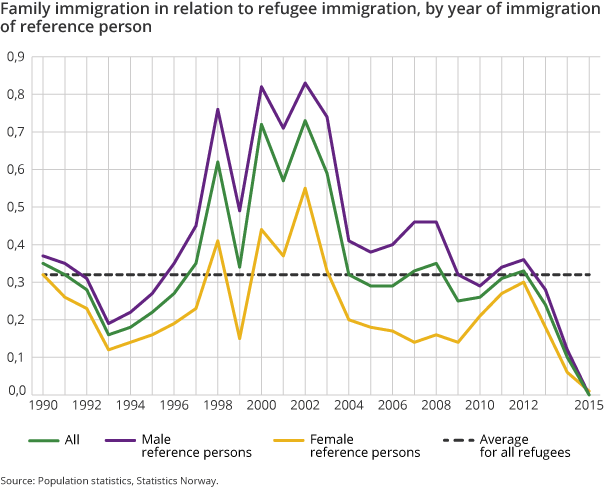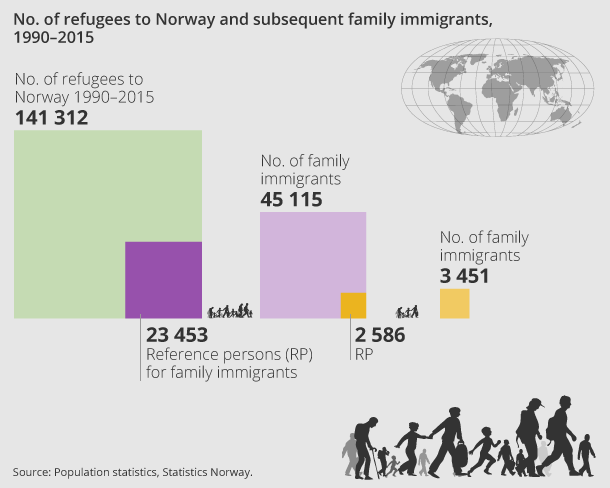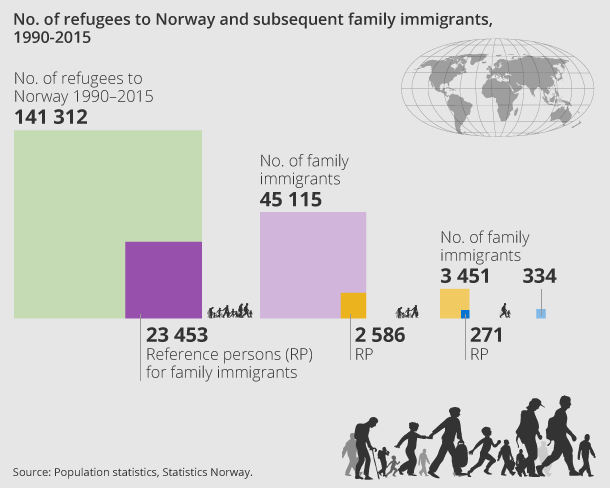Statistical analysis, 2017
Family immigration among refugees 1990-2015
How many refugees' families come to Norway?
Published:
This article was first published in Norwegian, in Statistics Norway’s journal Samfunnsspeilet: Dzamarija, Minja Tea og Toril Sandnes (2016): Familieinnvandring til flyktninger 1990–2015. Hvor mange får familien til Norge? Samfunnsspeilet 4/2016. Statistisk sentralbyrå.
In the period 1990–2015, 141 300 refugees found their way to Norway and were granted a residence permit. A total of 45 100 family members of 23 500 of these refugees have subsequently been accepted into Norway. This means that the majority of refugees do not have any family here. Country background has a large bearing on family immigration rates.
- Series archive
- Statistical analysis, 2017
According to the Norwegian Directorate of Immigration (UDI), more than 31 000 people applied for asylum in Norway in 2015, mostly from Syria, Afghanistan and Iraq (see UDI’s overview in this issue of Samfunnsspeilet). Questions have been raised about the need to restrict the right to family immigration for refugees. In the wake of the refugee crisis, it has been argued that the record number of asylum seekers in Norway in 2015 will trigger a marked increase in family immigration.
It is too soon to comment on family immigration among refugees who arrived in 2015, but the family immigration patterns of earlier refugees can give us an idea of the scope of the future family immigration. Statistics Norway has figures on reason for immigration from 1990 to 2015. During this period, 738 000 people immigrated to Norway from countries outside the Nordic region, and 141 300 of these were refugees.
One in every five immigrants in Norway was a refugee, which corresponds to 2.7 per cent of the population. Norway has refugees from 169 different countries, with most from Somalia, Iraq and Eritrea. Family immigrants of refugees make up just under one- fifth of all family immigrants, i.e. 45 100 of a total of 267 000 family immigrants (see the textbox for an explanation of terms).
0.32 family members per refugee
Family immigration has always played a key role in the growth of immigrant groups. The large influx of refugees has raised important questions in relation to immigration and integration policy. How many of those who have been granted residence in Norway will remain in the country? What is the scope of family-related immigration likely to be in the next few years?
This article examines immigrants who came to Norway in the period 1990–2015 as the family member of a refugee (reference person, see the box) who arrived during the same period. An average of 0.32 family members per refugee arrived during the period. This rate does not, however, take into account two important dimensions of family immigration, which we will examine later in this article:
- The time aspect, i.e. how long it takes for a refugee to get a family member to Norway – which can vary considerably.
- Multi-stage family immigration.
Seventeen per cent (23 500) of refugees have been able to get family members to Norway (see Figure 1). Eighty-three per cent have never acted as a reference person. Sixty per cent of the refugees who are registered as a reference person are only associated with one family member, while 15 per cent have two family members in Norway. In total, 1 900 refugees (8 per cent) have managed to get five or more family members into Norway. Among these are a few cases that have triggered an unusually high number of family immigrants; 54 reference persons, mostly from Somalia and Iraq, are registered with ten or more family members.
Meeting the requirements for family immigration can take time
As time passes, the number of family immigrants accepted into Norway will increase as the reference person, in this case a refugee, fulfils the various requirements for family immigration, such as four years of education or work in Norway (Lovdata).
Meeting these requirements may take several years, so we have also examined family immigrants during the period 1990–2015 for refugees who arrived during the period 1990–2010. The average for this sub-group is 0.37 family members per refugee. Refugees who arrived in Norway after 2010 constitute a relatively large share of the total number of refugees, but few have managed to get family members into Norway.
We have calculated the number of family immigrants of refugees for each year from 1990 to 2015. Men and women who immigrated as refugees in the period 2002–2003 had the most family immigrants per reference person. The figures peaked in 2002, with 0.73 family immigrants per refugee. Refugees who arrived in Norway after 2012 have not been here long enough to secure as many family immigrants as can perhaps be expected (see Figure 2).
Somalis and Iraqis have highest family immigration levels
The share of family immigrants of refugees varies by country background. Somalis make up the largest refugee group in Norway, and together with Iraqis, have the most family members in Norway through family immigration (see Figure 3).
A total of almost 17 900 refugees from Somalia arrived in Norway in the years 1990 to 2015. This group now has 12 300 family members in the country as a result of family immigration in the same period. The numbers have varied, and reached a peak around the turn of the millennium.
The entire 2002 cohort as a whole currently has the most family immigrants, with 1.30 per refugee. The family immigration rate for Somalia for the period 1990–2015 is 0.68 family members per refugee, which is roughly double the rate for all refugees as a whole in the same 15-year period (0.32).
The influx of refugees from Somalia has been high in several of the years since the turn of the millennium. It is therefore reasonable to assume that future family immigration among these refugees will be even higher than pre-2015 levels. However, there has also been a substantial decline in immigration from Somalia in the past two to three years. In 2013, the number of newly arrived refugees was 1 400, compared to just 200 in 2015 (Dzamarija and Sandnes 2016).
Iraqis make up the second largest refugee group in Norway. In the period 1990–2015, 14 500 refugees arrived from Iraq. A total of 8 500 family immigrants of this group have subsequently come to Norway, which corresponds to 0.58 family members per refugee. The largest cohorts from around the turn of the millennium have led to the bulk of family immigration. The 1999 cohort tops the list with 1.29 family members per refugee. In absolute numbers, the 2000 cohort stands out with high immigration figures: 3 500 refugees from Iraq have received 3 000 family immigrants, which corresponds to 0.86 family members per refugee.
Since 2010, the number of refugees and family immigrants from Iraq has been modest. It is therefore reasonable to assume that future family immigration for these groups will be correspondingly low.
Many of the asylum seekers who came to Norway in autumn 2015 were from Iraq. If they are all granted residence in Norway, the number of Iraqi family immigrants is likely to increase.
For Bosnians and Kosovan Albanians, the number of years in Norway has not had such a large bearing on family immigration. These refugee groups mostly came to Norway as families, and there are very few from these countries who can now be granted residence as a refugee in Norway.
Many Syrians awaiting residence to be granted
Since the large influx in 2015, Syrian citizens are by far the largest group in Norwegian asylum reception centres in 2016. Statistics Norway’s statistics do not include asylum seekers awaiting a decision, but the number of settled Syrian immigrants almost doubled in 2015.
It is too soon to know the scope of family immigration for Syrians who came to Norway as asylum seekers in 2015, or who were settled as refugees in this year, but we know that the 2013 cohort, made up of just under 1 000 people, has resulted in 0.37 family immigrants per refugee. The 2015 cohort is the largest, with 3 500 registered settled refugees, but they understandably have very few family immigrants so far.
Female family immigrants in the majority
Of the family immigrants who have arrived since 1990, 77 per cent have come through family reunification, while the remainder have come to establish a new family through marriage (see box for explanation of terms). A total of 61 per cent of all family immigrants in the period 1990–2015 were women.
Two countries stand out in several stages of family immigration
Further examination of the figures can show whether those who came to Norway as a family member of a refugee subsequently became a reference person for one or more family immigrants. Figures for the period from 1990 to 2015 show that 2 600 (6 per cent) of the 45 100 family immigrants have become a reference person, and have brought 3 450 new family members to the country (see Figure 4).
These family immigrants include children who were left behind in their homeland with grandparents or other family members when their mother was reunited with their father in Norway, or when their mother remarried. The children were subsequently reunited with their mother. These family immigrants may also be someone who has come to Norway to marry a refugee’s family immigrant.
Eighty per cent (2 060 people) of those who came as a refugee’s family member, and who are themselves a reference person, have managed to get one family member into Norway, while 1.5 per cent (around 40 people) now have five or more new family members in the country.
In terms of country background, there are two countries that stand out: Iraq and Somalia. Approximately 800 family members came to earlier family immigrants from Iraq, and 700 to the corresponding group from Somalia. A further 300 family immigrants of earlier family immigrants were accepted from Vietnam, and around 250 from Afghanistan and Sri Lanka.
When we examine those who arrived in the period 1990–2015 as family members (3 450) of family immigrants (45 100) of refugees (141 300), we see that 270 of the 3 450 family immigrants in the second stage are reference persons for more than 330 new family immigrants (see Figure 5). One such example is where a refugee has arrived in Norway and his wife and children have followed at a later date. The wife’s mother has then been accepted into Norway, and she then manages to get her husband into the country. The rate increases from 0.32 to 0.35 family members per refugee when we factor in third-stage family immigration (see Figure 5).
The majority of family immigrants do not therefore have any family members in the country through family immigration. Although the figures for third-stage family immigration are low, we nevertheless find some cases where one reference person has managed to get two or more family members into Norway.
Of the 330 family immigrants who have arrived through family immigration in three stages, the majority had a reference person from Iraq or Somalia, with this constituting 70 and 50 people respectively.
Family members of one in ten unaccompanied refugee minors accepted into Norway
Is it more common for unaccompanied refugee minors’ families to come to Norway than the families of other refugees? The unaccompanied minors were all under 18 when they came to Norway, and they applied for asylum and were granted residence without their parents.
Unaccompanied refugee minors constitute 5 per cent of the refugees who have arrived since 1990. During this period, there have been 6 900 refugees, with more than half arriving after 2009. Most have backgrounds from Afghanistan, Somalia, Eritrea and Iraq (Dalgard 2016).
Our figures show that 12 per cent of unaccompanied refugee minors have acted as a reference person for one or more family immigrants. In absolute numbers, around 800 unaccompanied refugee minors managed to get 1 125 family members into Norway. This corresponds to 0.16 family members per unaccompanied refugee minor.
Eighty-one per cent of the unaccompanied minors who were registered as a reference person have managed to get one family member into Norway, while 9 per cent managed two. The corresponding figure for five or more family members is less than 3 per cent.
Of the 1 125 family immigrants who have been accepted into Norway through an unaccompanied refugee minor, spouses constitute 56 per cent, parents 17 per cent and siblings and other relatives 20 per cent. Family establishment is thus more prevalent than family reunification for the unaccompanied refugee minors, compared with other refugees (Pettersen 2007).
What factors influence the scope of family immigration?
We have examined three factors that have a bearing on the scope of family immigration to Norway:
- Time aspect, i.e. the time elapsed from when a refugee is granted residence until a family member arrives through family immigration.
- What country they come from. There are major disparities here. Many refugees only get a few family members into Norway. Two countries that stand out with high rates of family immigration are Iraq and Somalia.
- We also see that family immigration via a refugee that takes place indirectly through various stages has a certain impact. The rate increases from 0.32 family immigrants per refugee to 0.35.
Our figures show that family immigration via unaccompanied refugee minors is a limited phenomenon. Few of those who arrived in Norway in the period 1996–2015 have acted as a reference person for one or more family members.
References
Dalgard A. B. (2016, 14.03.). Enslige mindreårige flyktninger i arbeid og utdanning, 2014: 90 pro- sent fra Afghanistan i arbeid og utdanning etter fire år (in Norwegian only). Retrieved from https://www.ssb.no/arbeid-og- lonn/artikler-og-publikasjoner/90-prosent-fra-afghanistan-i-arbeid-og-utdanning-etter-fire-ar
Dzamarija M. T., & Sandnes, T. (2016). Familieinn- vandring og ekteskapsmønster 1990-2015 (Rap- porter 2016/39) (in Norwegian only, with English abstract). Retrieved from http://www.ssb.no/ befolkning/artikler-og-publikasjoner/familieinn- vandring-og-ekteskapsmonster-19902015
Immigration Regulations. (2009). Regulations concerning the entry of foreign nationals into the Kingdom of Norway and their presence in the realm. Viewed at http://app.uio.no/ub/ujur/oversatte-lover/data/for-19901221-1028-eng.pdf
Pettersen, S. V. (2007). Enslig mindreårige asylsøkere og gjenforening med foreldre (Notater 2007/58) (in Norwegian only). Retrieved from http://www.ssb.no/befolkning/arti- kler-og-publikasjoner/enslige-mindreaarige-asyl- sokere-og-gjenforening-med-foreldre?fane=om
Contact
-
Statistics Norway's Information Centre





